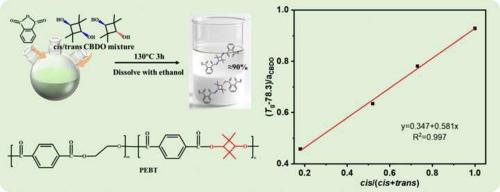Separation of cis–trans CBDO and the effect of its cis–trans isomers on the properties of modified PET co-polyesters
IF 6.3
2区 化学
Q1 POLYMER SCIENCE
引用次数: 0
Abstract
2,2,4,4-Tetramethyl-1,3-cyclobutanediol (CBDO) modified co-polyesters are expected to replace bisphenol A polycarbonate applications in many fields, and the cis–trans isomerisation of CBDO directly affects the co-polyester properties. However, the separation of cis–trans CBDO isomers and the influence of cis–trans isomer ratio on the performance of co-polyester are poorly investigated at present. In this paper, an efficient method of separating cis–trans CBDO isomers was proposed, and CBDO modified PET co-polyesters (PEBT) with a total CBDO content of about 40 % and a cis-CBDO content of 20–100 % were synthesized by modulating the cis- content. The glass transition temperature (Tg) of the co-polyester with 100 % cis-CBDO was as high as 117.8 °C, and the increment in Tg of the co-polyester with per mol of cis-CBDO introduced was calculated to be 0.92 °C, which was 2.7 times of the increment of trans-CBDO (0.34 °C). With the increase of cis-CBDO content from 20 % to 100 %, the tensile strength was correspondingly increased from 35.4 MPa to 40.2 MPa, and the elongation at break decreased from 74 % to 18 %, respectively. This paper provides a theoretical basis for the preparation of high-performance CBDO-modified co-polyesters.

顺反式CBDO的分离及其顺反式异构体对改性PET共聚酯性能的影响
2,2,4,4-四甲基-1,3-环丁二醇(CBDO)改性共聚酯有望取代双酚A聚碳酸酯在许多领域的应用,而CBDO的顺反异构化直接影响到共聚酯的性能。然而,目前对CBDO顺反异构体的分离以及顺反比对共聚酯性能的影响研究较少。本文提出了一种分离顺式-反式CBDO异构体的有效方法,通过调节顺式含量,合成了CBDO修饰的PET共聚酯(PEBT),总CBDO含量约为40%,顺式CBDO含量为20 - 100%。加入100%顺式cbdo的共聚酯的玻璃化转变温度(Tg)高达117.8℃,计算出每mol顺式cbdo引入共聚酯的Tg增量为0.92℃,是反式cbdo增量(0.34℃)的2.7倍。随着顺式cbdo含量从20%增加到100%,拉伸强度从35.4 MPa增加到40.2 MPa,断裂伸长率从74%下降到18%。本文为制备高性能cbdo改性共聚酯提供了理论依据。
本文章由计算机程序翻译,如有差异,请以英文原文为准。
求助全文
约1分钟内获得全文
求助全文
来源期刊

European Polymer Journal
化学-高分子科学
CiteScore
9.90
自引率
10.00%
发文量
691
审稿时长
23 days
期刊介绍:
European Polymer Journal is dedicated to publishing work on fundamental and applied polymer chemistry and macromolecular materials. The journal covers all aspects of polymer synthesis, including polymerization mechanisms and chemical functional transformations, with a focus on novel polymers and the relationships between molecular structure and polymer properties. In addition, we welcome submissions on bio-based or renewable polymers, stimuli-responsive systems and polymer bio-hybrids. European Polymer Journal also publishes research on the biomedical application of polymers, including drug delivery and regenerative medicine. The main scope is covered but not limited to the following core research areas:
Polymer synthesis and functionalization
• Novel synthetic routes for polymerization, functional modification, controlled/living polymerization and precision polymers.
Stimuli-responsive polymers
• Including shape memory and self-healing polymers.
Supramolecular polymers and self-assembly
• Molecular recognition and higher order polymer structures.
Renewable and sustainable polymers
• Bio-based, biodegradable and anti-microbial polymers and polymeric bio-nanocomposites.
Polymers at interfaces and surfaces
• Chemistry and engineering of surfaces with biological relevance, including patterning, antifouling polymers and polymers for membrane applications.
Biomedical applications and nanomedicine
• Polymers for regenerative medicine, drug delivery molecular release and gene therapy
The scope of European Polymer Journal no longer includes Polymer Physics.
 求助内容:
求助内容: 应助结果提醒方式:
应助结果提醒方式:


